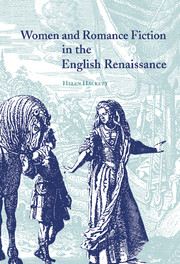Book contents
- Frontmatter
- Contents
- Acknowledgements
- List of abbreviations and a note on the text
- Introduction
- 1 The readership of Renaissance romance
- 2 Renaissance romance and modern romance
- 3 Novellas of the 1560s and 1570s
- 4 Spanish and Portuguese romances
- 5 Fictions addressed to women by Lyly, Rich and Greene
- 6 The ‘Arcadia’: readership and authorship
- 7 The ‘Arcadia’: heroines
- 8 ‘The Faerie Queene’
- 9 Shakespeare's romance sources
- 10 Lady Mary Wroth's ‘Urania’
- Epilogue: The later seventeenth century
- Notes
- Bibliography
- Index
2 - Renaissance romance and modern romance
Published online by Cambridge University Press: 01 September 2009
- Frontmatter
- Contents
- Acknowledgements
- List of abbreviations and a note on the text
- Introduction
- 1 The readership of Renaissance romance
- 2 Renaissance romance and modern romance
- 3 Novellas of the 1560s and 1570s
- 4 Spanish and Portuguese romances
- 5 Fictions addressed to women by Lyly, Rich and Greene
- 6 The ‘Arcadia’: readership and authorship
- 7 The ‘Arcadia’: heroines
- 8 ‘The Faerie Queene’
- 9 Shakespeare's romance sources
- 10 Lady Mary Wroth's ‘Urania’
- Epilogue: The later seventeenth century
- Notes
- Bibliography
- Index
Summary
RENAISSANCE ROMANCE AS POPULAR CULTURE?
The readership of Renaissance romance was often constructed not only as female but also as middling in class. Lyly, Rich and Greene described their imagined readers as ‘gentlewomen’: that is, of the gentry class, a notch below the nobility, but able to live without recourse to manual labour. Later, as we have seen, Overbury's Characters and other satires identified the chief readers of romances as maidservants. Going along with such middling class designations, romance was often denigrated as a ‘low’ genre both by the moralists who condemned it, and by many of the authors who wrote it and who presented their works as toys and trifles. Lyly even used the term ‘trash’ in his prefatory epistle to Euphues and his England (pp. 200–1).
Taking such representations at face value, modern critics often draw casual comparisons between Renaissance romance and modern forms of popular culture. Sheldon P. Zitner, seeking to understand Lord Herbert of Cherbury's enthusiasm for romance, suggests ‘Perhaps we are dealing with a half-secret intellectual indulgence – like television.’ David Margolies speculates that ‘Fiction may well have been regarded by the Elizabethans in the same way as cinema early in this century’, as a vulgar and ephemeral amusement.
In particular, the idea of Renaissance romance as women's reading is often bound up with suggestions that it is directly comparable with modern romantic fiction.
- Type
- Chapter
- Information
- Women and Romance Fiction in the English Renaissance , pp. 20 - 32Publisher: Cambridge University PressPrint publication year: 2000



